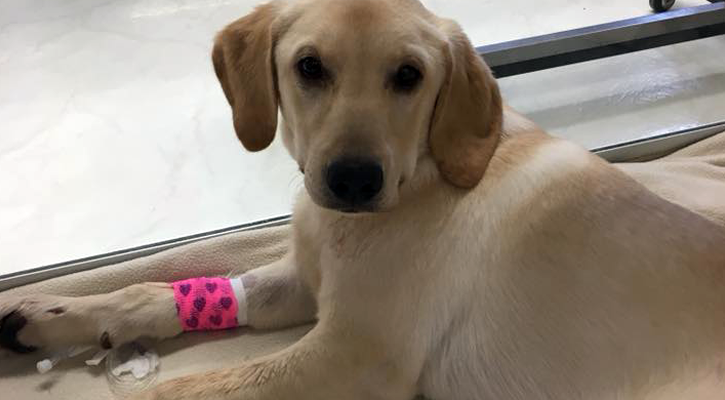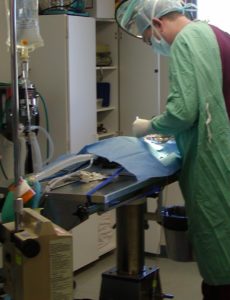
Surgery
Many people have questions about various aspects of their pet’s surgery, and we hope this information will help. It also explains the decisions you will need to make before your pet’s upcoming surgery.

Is anesthesia safe?
Today’s modern anesthetic monitors have made surgery much safer than in the past. Here at Oakview Veterinary Medical Center, we do a thorough physical exam on your pet before administering anesthetics to ensure that a fever or other illness won’t be a problem. We also adjust the amount and type of anesthetic used depending on the health of your pet.
Preanesthetic blood testing is important in reducing the risk of anesthesia. Every pet needs blood testing before surgery to ensure that the liver and kidneys can handle the anesthetic. Even apparently healthy animals can have serious organ system problems that cannot be detected without blood testing. If there is a problem, it is much better to find it before it causes anesthetic or surgical complications. If serious problems are detected, surgery can be postponed until the problem is corrected.
It is important that surgery is done on an empty stomach to reduce the risk of vomiting during and after anesthesia. You will need to withhold food for at least 8 hours before surgery; however, we do recommend that pets eat a small snack at bedtime the night before surgery. Withholding food for too long can also cause problems. Water can be left down for the pet until the morning of surgery.
We do everything possible to ensure the safety of every one of our patients. That includes fluids to ensure that your pet remains hydrated and their blood pressure is maintained. Most patients have an intravenous catheter placed for the administration of these fluids and medications. And the most important safety step is the close monitoring of the patient by well-trained and dedicated Certified Veterinary Technicians and veterinary assistants.
Will my pet have stitches?
For many surgeries, we use absorbable sutures underneath the skin. These will dissolve on their own, and do not need to be removed later. Some surgeries, especially tumor removals, do require skin stitches or staples. With any type of sutures or staples, you will need to keep an eye on the incision for swelling or discharge. Most dogs and cats do not lick excessively or chew at the incision, but this is an occasional problem you will also need to watch for. If there are skin sutures, these will usually be removed 10 to 14 days after surgery. You will also need to limit your pet’s activity level for a time and no baths are allowed for the first 10 days after surgery.
Will my pet be in pain?
Anything that causes pain in people can be expected to cause pain in animals. Pets may not show the same symptoms of pain as people do; they usually don’t whine or cry, but you can be sure they feel it. Pain medications needed will depend on the surgery performed. Major procedures require more pain relief than things like minor lacerations.
For dogs, we may recommend an oral anti-inflammatory the day after surgery and several days after to lessen the risk of discomfort and swelling. We use newer medications, which are less likely to cause stomach upset and can be given even the morning of surgery.
Because cats do not tolerate standard pain medications we are limited in what we can give them. Recent advances in pain medications have allowed for better pain control in cats than ever before. We administer pain medication prior to surgery. After surgery, pain medication is continued for 3-5 days. Any animal that appears painful will receive additional pain medication.
Injectable pain medications may also be used after surgery on both dogs and cats. Providing whatever pain relief is appropriate is a humane and caring thing to do for your pet.
What other decisions do I need to make?
While your pet is under anesthesia, it is the ideal time to perform other minor procedures such as ear cleaning or implanting an identification microchip. If you would like an estimate for these extra services, please call ahead of time. This is especially important if the person dropping the pet off for surgery is not the primary decision maker for the pet’s care.
When you bring your pet in for surgery, we will need at least 5 to 10 minutes of time to fill out paperwork and meet some of the surgery team. When you pick up your pet after surgery you can also plan to spend about 10 minutes to go over your pet’s home care needs.
We will call you the night before your scheduled surgery appointment, to confirm the time you will be dropping your pet off and to answer any questions you might have. In the meantime, please don’t hesitate to call us with any questions about your pet’s health or surgery.
Pet Surgery In Plover, Wisconsin
Visit Oakview Veterinary Medical Center for your pet’s surgeries! Contact us today or give our hospital a call at 717-344-6311 to schedule an appointment.!
Explore Our Complete List of Veterinary Services in Plover, WI
- Diabetes Mellitus Management
- Cryotherapy
- Feline Care
- Canine Care
- Rehabilitation Therapy
- Exotic & Avian Pets
- Dental Care
- Behavior Concerns
- Club Vet Boarding Kennel
- Laser Therapy
- Advanced Imaging
- End of Life Resources
- Senior Wellness
- Vaccinations
- In-House Laboratory
- Spay & Neuter
- Microchipping
- Wellness Exams
